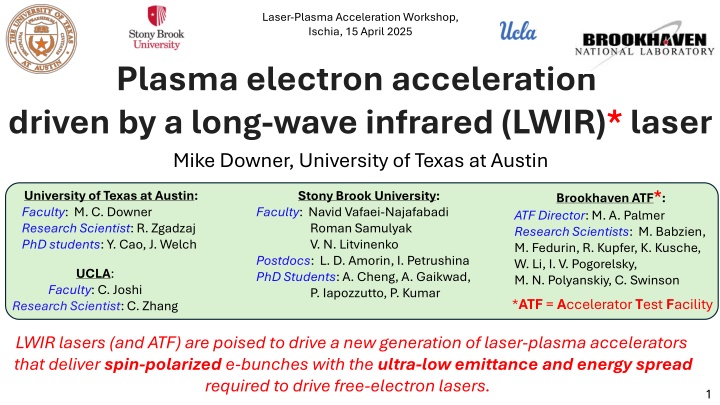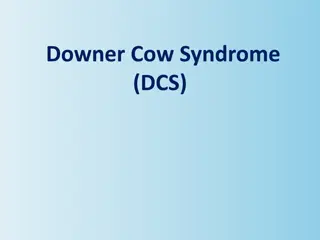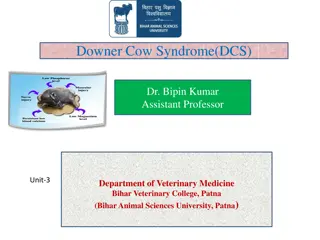
Laser-Plasma Acceleration Workshop Highlights Cutting-Edge Research
Explore the latest advancements in laser-plasma acceleration from the Laser-Plasma Acceleration Workshop in Ischia. Discover how LWIR lasers and other technologies are revolutionizing electron acceleration and driving innovations in free-electron lasers, plasma bubbles, and more.
Download Presentation

Please find below an Image/Link to download the presentation.
The content on the website is provided AS IS for your information and personal use only. It may not be sold, licensed, or shared on other websites without obtaining consent from the author. If you encounter any issues during the download, it is possible that the publisher has removed the file from their server.
You are allowed to download the files provided on this website for personal or commercial use, subject to the condition that they are used lawfully. All files are the property of their respective owners.
The content on the website is provided AS IS for your information and personal use only. It may not be sold, licensed, or shared on other websites without obtaining consent from the author.
E N D
Presentation Transcript
Laser-Plasma Acceleration Workshop, Ischia, 15 April 2025 Plasma electron acceleration driven by a long-wave infrared (LWIR)* laser Mike Downer, University of Texas at Austin Brookhaven ATF*: ATF Director: M. A. Palmer Research Scientists: M. Babzien, M. Fedurin, R. Kupfer, K. Kusche, W. Li, I. V. Pogorelsky, M. N. Polyanskiy, C. Swinson *ATF = Accelerator Test Facility University of Texas at Austin: Faculty: M. C. Downer Research Scientist: R. Zgadzaj PhD students: Y. Cao, J. Welch Stony Brook University: Faculty: Navid Vafaei-Najafabadi Roman Samulyak V. N. Litvinenko Postdocs: L. D. Amorin, I. Petrushina PhD Students: A. Cheng, A. Gaikwad, P. Iapozzutto, P. Kumar UCLA: Faculty: C. Joshi Research Scientist: C. Zhang LWIR lasers (and ATF) are poised to drive a new generation of laser-plasma accelerators * 8 < ? ? < 15 m LWFA driven my MWIR laser (3.9 m): Woodbury et al., Opt. Lett. 43, 1131 (2018) that deliver spin-polarized e-bunches with the ultra-low emittance and energy spread required to drive free-electron lasers. 1
Drive pulses with a0 4, p-1 , w0 p generate efficiently plasma bubbles . super-sized LWIR plasma bubbles ... Pogorelsky et al., PPCF 58, 034003 (2016). ne 2 1016 cm-3 ne 5 1018 cm-3 electron density (1018 cm-3) 10 Externally- injected e-bunches Externally- injected e-bunches 5 x = 0 mm x = 0.3 mm x = 0.6 mm 0 [ m]: 1 [fs]: 30 w0 [ m]: 10 30 8 0.007 [ m]: [fs]: w0 [ m]: Energy [J]: 1 10 500 120 12.5 1.6 within reach at ATF Polyanskiy et al., Photonics8, 101 (2021) 500 120 1250 ( 1 cycle) (w0 < ) 8 (inefficient, impractical) Max e- energy gain [GeV]: Laser Energy [J]: 0.7 Max e- energy gain [GeV]: 0.6 Plasma electrons do not self-inject. External injection is necessary. Plasma electrons self-inject into a region of strong EM field gradients. ...that preserve the low n, low Ee/Ee, spin polarization of linac-injected e-bunches. 2
TW CO2 laser technology & LWFA science advance hand-in-hand CO2 laser technology LWFA regime wake structure Kumar, Phys. Plasmas 28, 013102 (2021) 100 plasma parameters & diagnostics electrons 10-15J, 0.5 ps, 20-30 TW CO2: isotopically enriched, 9R + 9P branches CPA: augmented by nonlinear post-compression Polyanskiy, Opt. Expr. 29, 31714 (2021) bubble regime x [ m] ? ?n/ne0 1 < ne 4 1016 cm-3 electron radiography, Faraday rotation external injection linac (synched, compressed) 2-color ionization 0 AE-?? (2024-26) -100 z [mm] P = 20 TW, ne0 = 2x1016 cm-3, a0 = 3.8 ATF pulse 3-10J, 2 ps, 1.5-5 TW CO2: isotopically enriched, 9R branch, ? = 9.2 m CPA: 140 ps stretch; 100 l/mm, 75% T compressor Polyanskiy, OSA Cont. 3, 459 (2020) nonlinear SM-LWFA, forced LWFA AE-95 (2022-24) Q 1-500 pC Ee 5-25 MeV 1 < ne < 4 x 1017 cm-3 1.7 > Pcr > 0.5 TW electron spectrometer exponential & peaked electron spectra nonlinear wake CPA (ATF) 2J, 4 ps, 0.5 TW CO2:natural, 10R branch, ? = 10.3 m CPA: 25 ps stretch; 75 l/mm, 50% T compressor Polyanskiy, Optica 2, 675 (2015) linear SM*-LWFA (*Self-Modulated) AE-71 (2018-20) 0.5 < ne < 2 x 1018 cm-3 0.4 > Pcr > 0.1 TW collective Thomson scatter NONE linear wake laser PBWA Plasma Beat- Wave Accelerator Clayton, PRL70, 37 (1993) 60J, 300 ps, 0.2 TW 1 = 10.59 m; 2 = 10.29 m (MARS) 2-color Q 5 fC Ee 9 MeV ne = 8.6 x 1015 cm-3 3 linear wake
SPACE* simulations predicted detectable SM wakes, but no accelerated electrons for PL = 0.5 TW (2 J, 4 ps) CO2 pulses Yu et al., Comp. Phys. Commun.277, 108396 (2022). * 3D, parallel, relativistic PIC * z [mm] *ion motion and atomic physics included simulations by... Prof. Roman Samulyak Only pz attributable to wake itself are observed. Aiqi Cheng 4
Collective Thomson Scatter (CTS)* experiments to observe wakes Slusher, Phys. Fluids 23, 472 (1980) Villenueve, JOSA B 8, 895 (1991) anti- Stokes Stokes * difference- frequency sum- frequency 1.69 t 1.45 ne [1018 cm-3] Notch filtered 1.11 0.98 0.75 0.63 experiments led by... rms jitter: 1 ps 120 cycles, ~30 ?p-1 0.57 30 20 -30 collective Thomson shift [nm] -20 10 -10 0 Dr. Rafal Zgadzaj (UT-Austin) (data for t = 0, P = 0.5 TW, ne variable) 5
CTS data: variable CO2 laser power P (data for t = 0, ne = 1.3 1018 cm-3) Stokes/anti-Stokes sidebands appear for P > Pcr 6
CTS data: variable time delay t (ne = 1.5 1018 cm-3 , PL = 0.5 TW = 3.75 Pcr) 1 pu-pr x-corrn Averaged & normalized sideband amplitude PIC 0.5 EXP 0 transverse wakes plasma channel ion acoustic waves For further details, see: Zgadzaj et al., Nat. Commun. 15, 4037 (2024) epw decays by converting into 7
TW CO2 laser technology & LWFA science advance hand-in-hand CO2 laser technology LWFA regime wake structure Kumar, Phys. Plasmas 28, 013102 (2021) 100 plasma parameters & diagnostics electrons 10-15J, 0.5 ps, 20-30 TW CO2: isotopically enriched, 9R + 9P branches CPA: augmented by nonlinear post-compression Polyanskiy, Opt. Expr. 29, 31714 (2021) bubble regime x [ m] ? ?n/ne0 1 < ne 4 1016 cm-3 electron radiography, Faraday rotation external injection linac (synched, compressed) 2-color ionization 0 AE-?? (2024-26) -100 z [mm] P = 20 TW, ne0 = 2x1016 cm-3, a0 = 3.8 ATF pulse 3-6J, 2 ps, 1.5-3 TW CO2: isotopically enriched, 9R branch, ? = 9.2 m CPA: 140 ps stretch; 100 l/mm, 75% T compressor Polyanskiy, OSA Cont. 3, 459 (2020) nonlinear SM-LWFA, forced LWFA AE-95 (2022-24) Q 1-500 pC Ee 5-25 MeV 0.3 < ne < 4 x 1017 cm-3 1.7 > Pcr > 0.5 TW electron spectrometer exponential & peaked electron spectra nonlinear wake CPA (ATF) 2J, 4 ps, 0.5 TW CO2:natural, 10R branch, ? = 10.3 m CPA: 25 ps stretch; 75 l/mm, 50% T compressor Polyanskiy, Optica 2, 675 (2015) linear SM*-LWFA (*Self-Modulated) AE-71 (2018-20) 0.5 < ne < 2 x 1018 cm-3 0.4 > Pcr > 0.1 TW collective Thomson scatter NONE linear wake laser PBWA Plasma Beat- Wave Accelerator Clayton, PRL70, 37 (1993) 60J, 300 ps, 0.2 TW 1 = 10.59 m; 2 = 10.29 m (MARS) 2-color Q 5 fC Ee 9 MeV ne = 8.6 x 1015 cm-3 8 linear wake
SPACE simulations predicted electron injection and acceleration for PL = 2 TW (4 J, 2 ps) CO2 pulses simulations by A. Cheng & R. Samulyak Zgadzaj et al., Nat. Commun. 15, 4037 (2024) above e- injection threshold PL = 2 TW (4 J, 2 ps) ne = 5 1017 cm-3 0 2 1 z (mm) pz from trapped, accelerated e- observed simulations by... e- output Q 50 pC ?? ? MeV ?HWHM~ 75 mrad Prof. Roman Samulyak Aiqi Cheng 9
Detection and Characterization of relativistic electron beams P appearance thresholds all are sub-Pcr Qmax 500 pC For 2 TW pulses, self-focusing no longer essential to trigger LWFA. H2 jet e- Lanex (???)appearance thresholds all are relativistic ?0 CO2 pulse 2-5 J, 2ps CCD integrated luminescence total charge Q 10
Transverse profiles of 90% of e-beams have 2-components H2 jet e- Key to lineouts data Lanex wide Gaussian CO2 pulse 2-5 J, 2ps narrow Gaussian CCD wide (w) Gaussians: 60 < ?w < 120 mrad narrow (n) Gaussians: 12 < ?n < 18 mrad 11
Electron energy spectra have 2 corresponding components ne = 4 1017 cm-3 * H2 jet magnet * CCD Lanex * CO2 pulse 2-5 J, 2ps * Collimated quasi-monoenergetic e-spectral features transition from SM-LWFA bubble regime 12
Bubble Regime Forced LWFA* ~1016 cm-3 ~ 0.5 ps 4 1017 cm-3 3 1016 cm-3 ~ 10 J 4-6 J 2 ps 2 ps 4-6 J ~1/2 wake period 10 wake periods 3 wake periods * Malka et al., Electron acceleration by a wake field forcedby an intense ultrashort laser pulse Science298, 1596 (2002) 13
TW CO2 laser technology & LWFA science advance hand-in-hand CO2 laser technology LWFA regime wake structure Kumar, Phys. Plasmas 28, 013102 (2021) 100 plasma parameters & diagnostics electrons 10-15J, 0.5 ps, 20-30 TW CO2: isotopically enriched, 9R + 9P branches CPA: augmented by nonlinear post-compression Polyanskiy, Opt. Expr. 29, 31714 (2021) bubble regime x [ m] ? ?n/ne0 1 < ne 4 1016 cm-3 electron radiography, Faraday rotation external injection linac (synched, compressed) 2-color ionization 0 AE-?? (2024-26) -100 z [mm] P = 20 TW, ne0 = 2x1016 cm-3, a0 = 3.8 ATF pulse 3-10J, 2 ps, 1.5-5 TW CO2: isotopically enriched, 9R branch, ? = 9.2 m CPA: 140 ps stretch; 100 l/mm, 75% T compressor Polyanskiy, OSA Cont. 3, 459 (2020) nonlinear SM-LWFA, forced LWFA AE-95 (2020-24) Q 1-500 pC Ee 5-25 MeV 1 < ne < 4 x 1017 cm-3 1.7 > Pcr > 0.5 TW electron spectrometer exponential & peaked electron spectra nonlinear wake CPA (ATF) 2J, 4 ps, 0.5 TW CO2:natural, 10R branch, ? = 10.3 m CPA: 25 ps stretch; 75 l/mm, 50% T compressor Polyanskiy, Optica 2, 675 (2015) linear SM*-LWFA (*Self-Modulated) AE-71 (2018-20) 0.5 < ne < 2 x 1018 cm-3 0.4 > Pcr > 0.1 TW collective Thomson scatter NONE linear wake laser PBWA Plasma Beat- Wave Accelerator Clayton, PRL70, 37 (1993) 60J, 300 ps, 0.2 TW 1 = 10.59 m; 2 = 10.29 m (MARS) 2-color Q 5 fC Ee 9 MeV ne = 8.6 x 1015 cm-3 14 linear wake
Next-generation ATF experiments will inject ~ 70 MeV electrons from linac into large LWFA Dream parameters: 1) 10 fs laser-e-beam rms jitter 2) e-bunch compression to 10 fs 3) 20-25 TW CO2 pulse Actual parameters will depend on status of laser and linac development. Simulations are in progress to define experimental parameters 15
Simulations validated by experiments in SM regime can be trusted to predict bubble regime accurately Kumar, Phys. Plasmas28, 013102 (2021) n/n matched unmatched unmatched laser complete blowout incomplete blowout complete blowout longitudinal distance z [mm] P = 20 TW, = 0.5 ps w0 = 117 m, a0 = 2.4 ne = 2 x 1016 cm-3 Multiple ways to reach bubble regime P = 20 TW, = 0.5 ps w0 = 74 m, a0 = 3.8 ne = 2 x 1016 cm-3 P = 20 TW, = 1 ps w0 = 74 m, a0 = 3.8 ne = 2.3 x 1016 cm-3 no self-injection for z < 2.5 mm no e-laser overlap for 0.5 ps 16
Simulations of growth of Ee/Ee and emittance of externally injected e-bunches in large bubbles. See Tu WG1 poster Y. Cao, Simulations of externally-injected CO2-driven LWFA (a) ne = 1016 cm-3 (b) 2 externally injected e-bunches 0.5 ps CO2 pulse (c) Electron Energy (d) Evolution of Energy Spread (%) 17
OSIRIS* quasi-3D simulations show that large bubbles preserve energy spread & spin polarization of strategically injected e-bunches during acceleration Simulations by Z. Nie, F. Li and W. B. Mori (UCLA) after acceleration slightly depolarized accelerated e-bunch spin-polarized injected e-bunch E/E 0.25% sz injection point sz E = 330 MeV, E = 0.8 MeV accelerated e-bunch E = 65 MeV, E = 0.5 MeV injected e-bunch sy sy electron energy sx sx electron energy 0.07 0.34 1.0 1.0 [GeV] [GeV] sz E 0.33 0.8 0.8 0 0.3 0.6 1 2 50 100 0.06 0.32 z [mm] -7.0 -7.0 -6.5 -6.0 -6.5 -6.0 longitudinal distance z ct [c/ p] longitudinal distance z ct [c/ p] Depolarization due to spin precession is ~ few % Depends on coordinates of injection point Occurs predominantly from = 1 10, constant thereafter Simulation parameters: 18 * Fonseca et al., PPCF 55, 124011 (2013)
A bird in the hand... New compact TW-scale MIR/LWIR CPA laser technologies are emerging ... anticipated fs/mJ/TW 100/100/1 100/100/1 Gain medium references ? ? [ m] Cr: ZnSe Fe: ZnSe optically- pumped CO2 discharge- pumped CO2 2.5 4 - 5 Y. Wu et al., Sci. Rpts. 10, 7775 (2020) Y. Wu et al., in Emerging Laser Technol. for High-Power Ultrafast Science, ed. F. L gar (IOP, 2021) D. Tovey et al., Opt. Express 29, 31455 (2021) 500/500/1 ~10 Polyanskiy et al., Photonics 8, 101 (2021) 9.2 500/10000/20 ...to drive future LWFAs in the super-bubble regime. But for now, this is the only game in town! 18
SUMMARY Plasma e- acceleration driven by LWIR laser demonstrated at ATF Peak laser power: 2-3 TW Plasma density: 3e16 ne 4e17 cm-3 quasi-monoenergetic features forced LWFA Accelerated electrons: 5-10 MeV, plasma-injected, Zgadzaj et al., Nat Comms 15, 4037 (2024) record An upgraded ATF laser is poised to demonstrate low- Ee/Ee, low- emittance acceleration of electrons injected from the ATF linac. Injected e-: synchronized, compressed to fs scale Plasma: ne 1016 cm-3 CO2 laser: 0.5 ?L 2 ps; L ~ 10 J Plasma physicists need not re-invent the cathode. Use plasma for what God intended: compact particle acceleration. 19
Nat Comms 15, 4037 (2024) Thanks to all of these co- workers! Financial Support DoE grant DE-SC0014043 (Stony Brook U., N. Vafaei-Najafabadi, PI) DoE grant DE-SC0011617 (U. Texas-Austin, M. C. Downer, PI) DoE grant DE-SC0012704 (Brookhaven NL, M. A. Palmer, PI)
Centimeter-long LWFAs have progressed steadily toward multi-GeV electron energy... probe nuclear spin states, parity violation drive FELs, probe reso- nant particle interactions high bubble regime discovery luminosity at collider IP electron energy E-beam quality*, not energy, is the concern of the HEP research community. Q (nC) Ee/Ee Ee (GeV) spin 100 100 1.0 10 most RF accelerators 2015 all HEPAP quasi-monoenergetic research acceler- ators 10-1 10-1 ATF oppor- tunity 0.5 5 10-2 10-2 Report of Accelerator R&D Subpanel 0 10-3 10-3 0 2000 *energy spread, spin poln, emittance preservation, beam stability & control, high rep-rate, peak current, staging,... 2010 2020 Year conventional RF accelerator capability , tenspC charge ...but are stuck at 10% energy spread, unpolarized spins 22
There are near-term scientific opportunities even for currently available 2 ps pulses OSIRIS* simulations courtesy N. Vafaei-Najafabadi CO2 laser parameters: 10 J, 2 ps, 5 TW, w0 = 40 m, a0(vac) = 3.56 ne = 1016 cm-3 ne = 1014 cm-3 * Fonseca et al., PPCF 55, 124011 (2013)






















